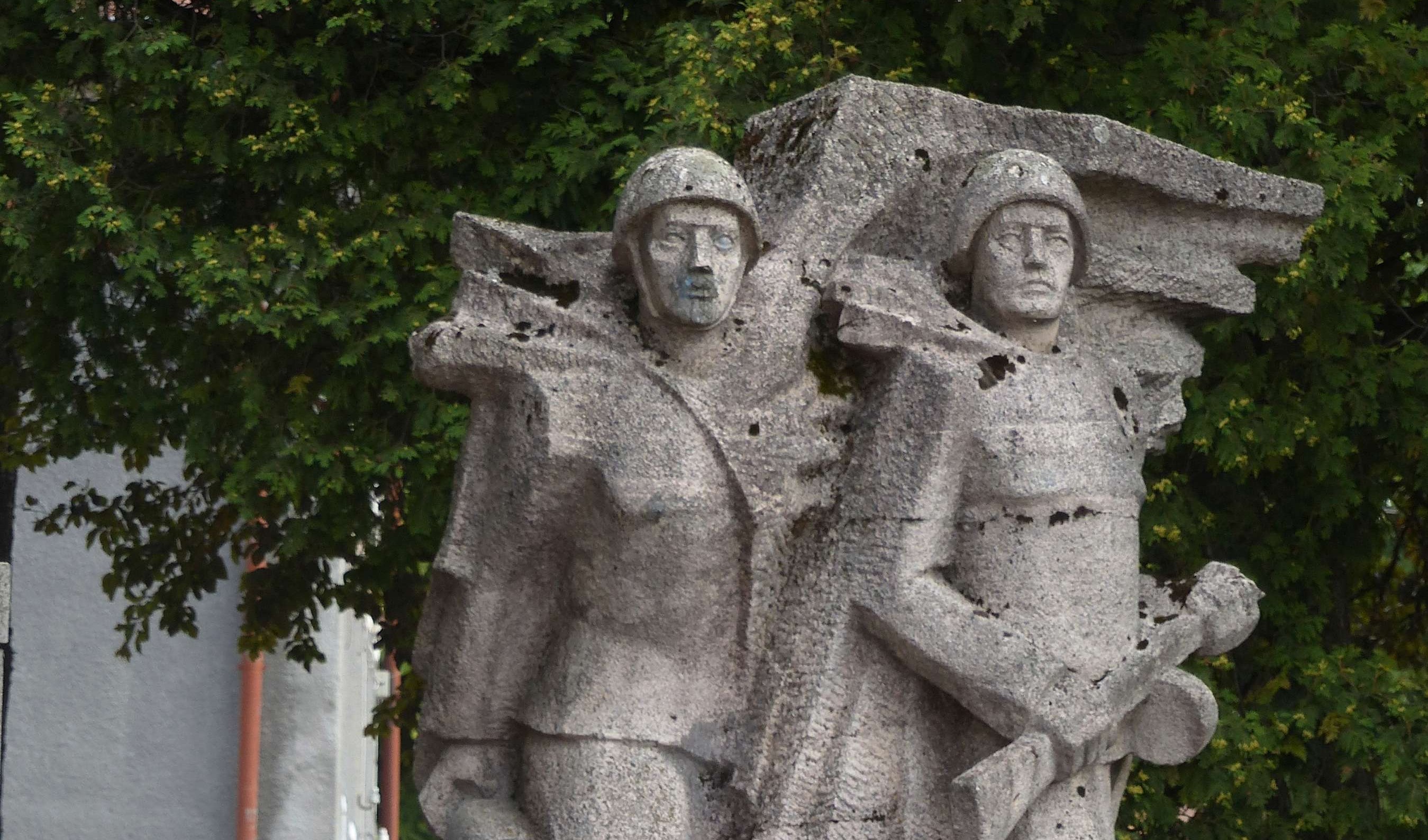Revision of World War Two History
 In September 2016 in the Polish city of Sanok the monument to the Red Army was dismantled.
In September 2016 in the Polish city of Sanok the monument to the Red Army was dismantled.
In Poland, the theory of “two occupations” is fairly popular, effectively equalizing the Nazi and Soviet regimes and considering the history of Poland in 1939-1989 as a period of one great occupation. The consequence after the theory of “two occupations” was the appearance of monument to the Soviet soldier-rapist on the Victory avenue in Gdansk on October 12, 2013. The author of the sculpture was a student of a local Academy of Fine Arts Jerzy Bogdan Szumczik. According to him, the work is devoted to the restoration of historical truth and the fate of women in wartime. The sculpture was removed on the morning of the next day by order of the municipal authorities and the police after the statements of angry locals. Administration of Gdansk stressed that did not give permission for the installation of the monument .
In late January, 2014, Penezhno municipality adopted a decision to demolish a monument to a Soviet General Ivan Chernyakhovsky. He was accused of taking part in repressions against the Home Army during the liberation of Lithuania .
In late June 2014, a monument of Gratitude to the Red Army was demolished in Limanowa . The monument in Limanowa is listed in the Polish-Russian agreement “On graves and places of memory of victims of war and repression”, signed in Krakow on February 22, 1994.
On September 17, 2014 around 200 nationalists gathered near the monument to the victims of Stalinism, marking 75th anniversary since the Soviet invasion. According to the adopted statement, Soviet regime in Poland was effectively genocide.
November 9, 2014 in the town Nowy Sącz (Lesser Poland), several dozen nationalists held a demonstration near the monument of the Red Army, demanding its dismantling. One of the organizers of the demonstration, activist of the Confederation of Independent Poland, Adam Slomka, attached a map of pre-war Poland depicting the division line between the German and Soviet armies in 1939 to the pedestal. "This should look like all the monuments established to commemorate the occupation of the invaders," - said A. Slomka.
In 2018, there were significant changes in Polish legislation concerning the history of World War II. Thus, according to Article 55a of the Law on the Institute of National Remembrance, adopted by the lower house of the Polish parliament in January 2018, "anyone who publicly and contrary to the facts states that the Polish nation or the Polish state is responsible for Nazi crimes committed by the German Third Reich (...) or for other crimes against peace, humanity or war crimes, or significantly reduces the responsibility of those actually responsible for these crimes, shall be fined or imprisoned for up to three years. The sentence shall be made public."
This amendment, or as it has been called, the "Holocaust Act," has caused both international and domestic scandal. The United States Holocaust Memorial Museum, for example, expressed concern that "the Act would chill free and open dialogue about Polish history during the Holocaust, including in Polish schools and universities, as well as in the media." The Polish Center for Holocaust Studies saw the following: "The adopted law is a tool designed to facilitate ideological manipulation and to impose the historical policy of the Polish state. The new legislation will be an unprecedented (and unknown in the democratic system) intrusion into the discussion of Polish history." The Polish authorities have argued that the new law is an unprecedented (and unknown in the democratic system) intrusion into the discussion of Polish history.
Polish authorities claim that Article 55a will be an effective tool for combating the unsubstantiated phrase: "Polish death camps". Meanwhile, it is clear that the amendment was a consequence of a view of World War II that has been spreading strongly in Eastern Europe in recent years, according to which all responsibility for war crimes fell on the Germans and locals had no responsibility for the Collaboration and Holocaust.
Since 2017, Poland has been implementing a law on decommunization, which also involves the demolition of monuments associated with the USSR. According to it, about 230 monuments to the fallen soldiers of the Red Army during World War II are to be destroyed. At that, they promised not to touch the burial places of the Soviet soldiers. Russian authorities believe that by destroying monuments, Europe is trying to rewrite history. According to Russian President Vladimir Putin, "this can be explained by internal political struggles in some countries and a desire to cheer up the electorate.
In April 2022, Poland's Institute of National Remembrance approved a list of 60 monuments to Soviet soldiers who died liberating Poland from Nazism. "We have a list of about 60 places from which monuments should be removed," said Karol Navrocki, head of the Institute of National Memory.
Nawrocki warned, however, that he would go to the recalcitrants and have a conversation. "They may have arguments that can convince me that the red star, the symbol of the system that killed 100 million people, should be in public space," he said. He stressed that if somewhere local authorities don't want to destroy the monuments, they "can expect me to visit."


